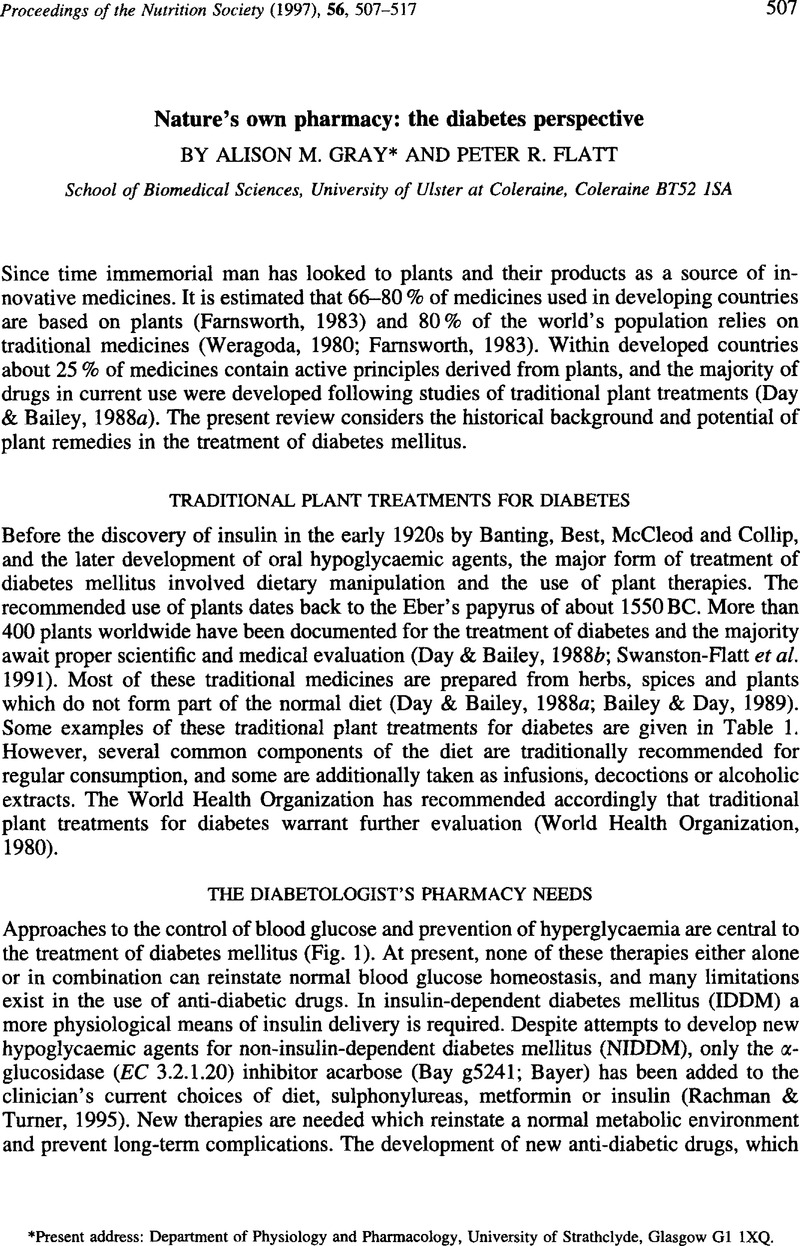Crossref Citations
This article has been cited by the following publications. This list is generated based on data provided by Crossref.
Gray, Alison M.
and
Flatt, Peter R.
1998.
Actions of the traditional anti-diabetic plant,Agrimony eupatoria(agrimony): effects on hyperglycaemia, cellular glucose metabolism and insulin secretion.
British Journal of Nutrition,
Vol. 80,
Issue. 1,
p.
109.
Day, Caroline
1998.
Traditional plant treatments for diabetes mellitus: pharmaceutical foods.
British Journal of Nutrition,
Vol. 80,
Issue. 1,
p.
5.
Gray, Alison M.
and
Flatt, Peter R.
1998.
Antihyperglycemic Actions of Eucalyptus globulus (Eucalyptus) are Associated with Pancreatic and Extra-Pancreatic Effects in Mice.
The Journal of Nutrition,
Vol. 128,
Issue. 12,
p.
2319.
Gray, Alison M.
and
Flatt, Peter R.
1999.
Insulin-releasing and insulin-like activity of the traditional anti-diabetic plantCoriandrum sativum(coriander).
British Journal of Nutrition,
Vol. 81,
Issue. 3,
p.
203.
Gray, Alison M.
Abdel-Wahab, Yasser H.A.
and
Flatt, Peter R.
2000.
The Traditional Plant Treatment, Sambucus nigra (elder), Exhibits Insulin-Like and Insulin-Releasing Actions In Vitro.
The Journal of Nutrition,
Vol. 130,
Issue. 1,
p.
15.
Ross, Ivan A.
2001.
Medicinal Plants of the World.
p.
191.
Ross, Ivan A.
2001.
Medicinal Plants of the World.
p.
141.
Silva, L.B.
Santos, S.S.S.
Azevedo, C.R.
Cruz, M.A.L.
Venâncio, T.M.
Cavalcante, C.P.
Uchôa, A.F.
Astolfi Filho, S.
Oliveira, A.E.A.
Fernandes, K.V.S.
and
Xavier-Filho, J.
2002.
The leaves of green plants as well as a cyanobacterium, a red alga, and fungi contain insulin-like antigens.
Brazilian Journal of Medical and Biological Research,
Vol. 35,
Issue. 3,
p.
297.
Gallagher, A.M
Flatt, P.R
Duffy, G
and
Abdel-Wahab, Y.H.A
2003.
The effects of traditional antidiabetic plants on in vitro glucose diffusion.
Nutrition Research,
Vol. 23,
Issue. 3,
p.
413.
Venâncio, T.M.
Oliveira, A.E.A.
Silva, L.B.
Machado, O.L.T.
Fernandes, K.V.S.
and
Xavier-Filho, J.
2003.
A protein with amino acid sequence homology to bovine insulin is present in the legume Vigna unguiculata (cowpea).
Brazilian Journal of Medical and Biological Research,
Vol. 36,
Issue. 9,
p.
1167.
Lee, Jeong-Sook
2005.
Effects of Fomes fomentarius supplementation on antioxidant enzyme activities, blood glucose, and lipid profile in streptozotocin-induced diabetic rats.
Nutrition Research,
Vol. 25,
Issue. 2,
p.
187.
Scalbert, Augustin
Manach, Claudine
Morand, Christine
Rémésy, Christian
and
Jiménez, Liliana
2005.
Dietary Polyphenols and the Prevention of Diseases.
Critical Reviews in Food Science and Nutrition,
Vol. 45,
Issue. 4,
p.
287.
Ramesh, B.
and
Pugalendi, K.V.
2006.
Antihyperglycemic Effect of Umbelliferone in Streptozotocin-Diabetic Rats.
Journal of Medicinal Food,
Vol. 9,
Issue. 4,
p.
562.
Mathews, Jacqueline N.
Flatt, Peter R.
and
Abdel-Wahab, Yasser H.
2006.
Asparagus adscendens(Shweta musali) stimulates insulin secretion, insulin action and inhibits starch digestion.
British Journal of Nutrition,
Vol. 95,
Issue. 3,
p.
576.
Baskar, R.
Bhakshu, L.Md.
Vijaya Bharathi, G.
Sreenivasa Reddy, S.
Karuna, R.
Kesava Reddy, G.
and
Saralakumari, D.
2006.
Antihyperglycemic Activity of Aqueous Root Extract ofRubia cordifolia. in Streptozotocin-Induced Diabetic Rats.
Pharmaceutical Biology,
Vol. 44,
Issue. 6,
p.
475.
Al-Amin, Zainab M.
Thomson, Martha
Al-Qattan, Khaled K.
Peltonen-Shalaby, Riitta
and
Ali, Muslim
2006.
Anti-diabetic and hypolipidaemic properties of ginger ( Zingiber officinale) in streptozotocin-induced diabetic rats.
British Journal of Nutrition,
Vol. 96,
Issue. 04,
p.
660.
Sokeng, S.D.
Rokeya, B.
Hannan, J.M.A.
Junaida, K.
Zitech, P.
Ali, L.
Ngounou, G.
Lontsi, D.
and
Kamtchouing, P.
2007.
Inhibitory effect of Ipomoea aquatica extracts on glucose absorption using a perfused rat intestinal preparation.
Fitoterapia,
Vol. 78,
Issue. 7-8,
p.
526.
Bhavsar, Shefalee K.
Joshi, Paulomi
Shah, Mamta B.
and
Santani, D.D.
2007.
Investigation into Hepatoprotective Activity ofCitrus limon..
Pharmaceutical Biology,
Vol. 45,
Issue. 4,
p.
303.
Trimurtulu, Golakoti
Venkateswarlu, Somepalli
and
Subbaraju, Gottumukkala
2007.
Anti-Angiogenic Functional and Medicinal Foods.
Vol. 20072347,
Issue. ,
p.
469.
Kamgang, René
Youmbi Mboumi, Rostand
Foyet Fondjo, Angèle
Fokam Tagne, Michel Archange
Mengue N’dillé, Gabriel Patrice Roland
and
Ngogang Yonkeu, Jeanne
2007.
Antihyperglycaemic potential of the water–ethanol extract of Kalanchoe crenata (Crassulaceae).
Journal of Natural Medicines,
Vol. 62,
Issue. 1,
p.
34.



